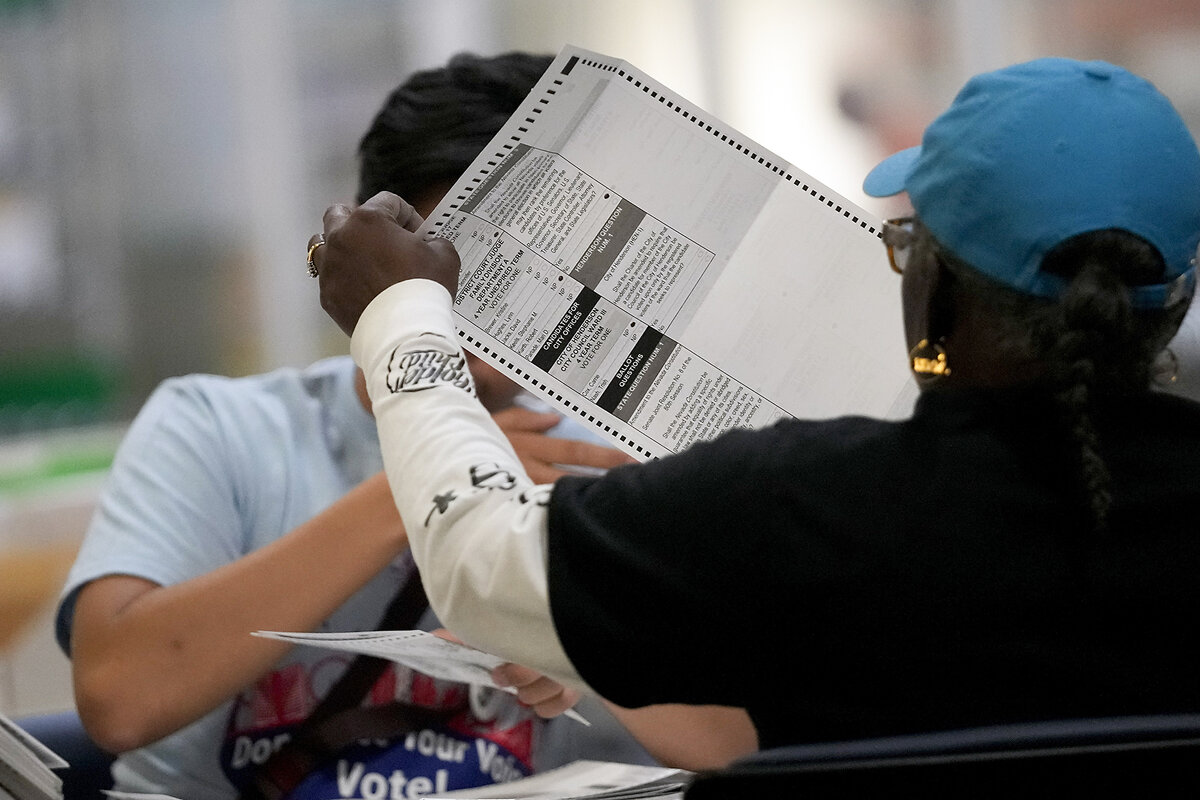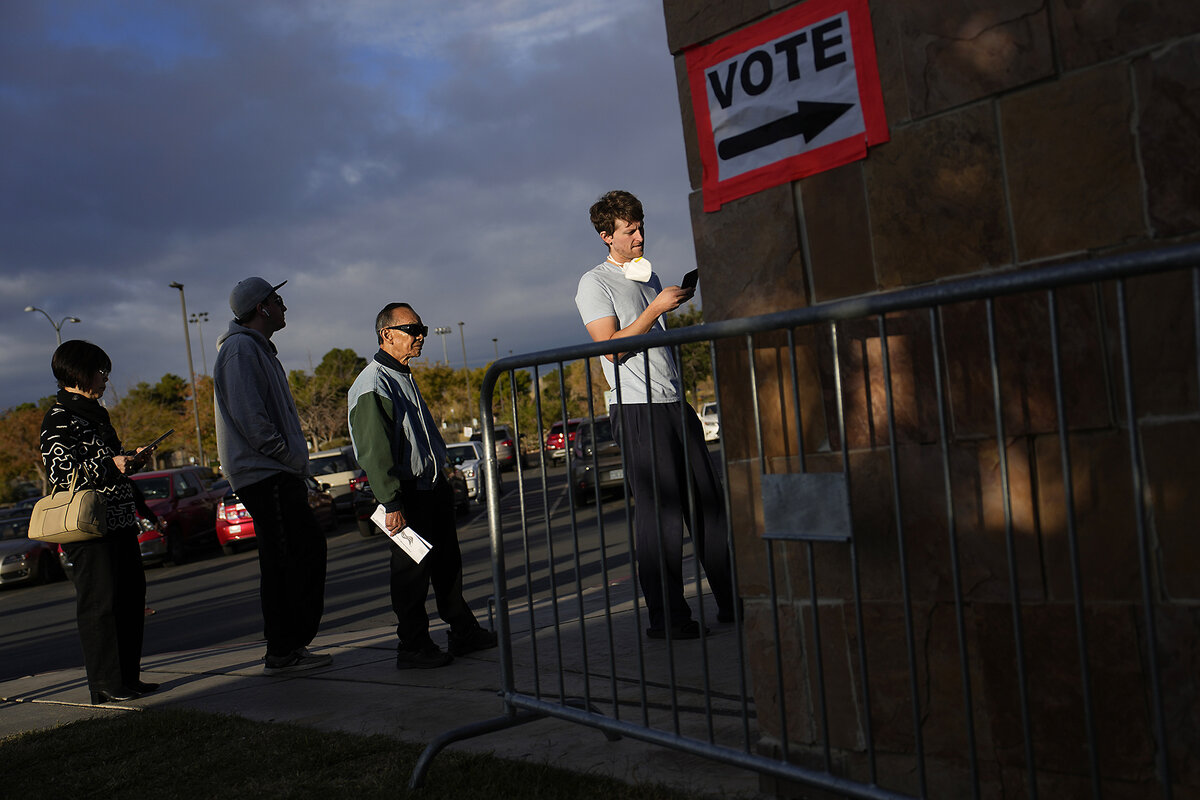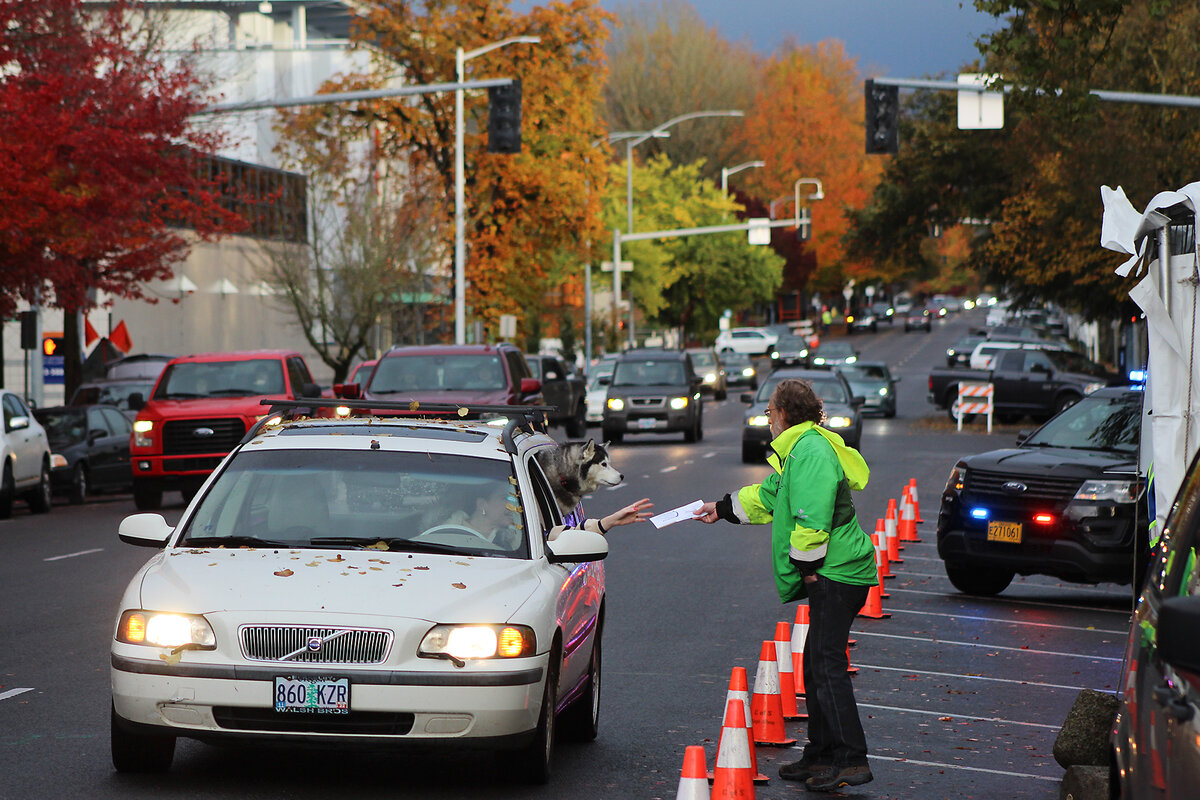Many Americans don’t trust mail-in voting. What can be done?
Loading...
“Mailed ballots are corrupt.”
They’re a “disaster” and “out of control.”
They’re “unsolicited, millions being sent to everybody.”
Why We Wrote This
A story focused onOverall, experts say election-related fraud in the United States is extremely rare. And safeguards are in place for mailed ballots. Yet distrust in the system remains high among Republican voters.
“You’re automatically going to have fraud.”
Since his rise to the heights of politics nine years ago, former U.S. President Donald Trump has continuously denounced mail-in voting as a concrete example of what he claims is endemic fraud in American elections.
Without evidence, he has depicted mail voting as an open portal in many states, an easy way for Democrats, foreign countries, or unauthorized immigrants to shovel millions of fake, election-flipping votes into the electoral system.
Recently his message has changed, as campaign advisers worry that President Joe Biden has built a large mail-in advantage in swing states. Absentee and early voting are “good options,” said a post on Mr. Trump’s Truth Social account this week.
But it may be difficult to undo what attacks have already accomplished. Suspicion about mail-in voting has become deeply entrenched among Republicans. Sixty-two percent of GOP and GOP-leaning voters oppose allowing people to vote using mailed ballots without an excuse, according to a 2023 Associated Press/NORC Center for Public Affairs poll. Among Democrats, the opinion is almost reversed: About 70% support no-excuse mail voting.
Election officials from both parties say mail-in ballots are a secure and effective means of increasing American participation in elections. It is true that many states relaxed restrictions on mail-in use for the 2020 election. But that was due to the COVID-19 pandemic, officials say, not a conspiracy to tilt the vote for Mr. Biden.
Experts add that they believe trust in mail-in votes – and in U.S. elections overall – can be rebuilt with communication and education. Transparency about how mail-in ballots are distributed, handled, and counted could counteract disinformation that calls the practice into question.
Voting used to happen “in view of the public,” says Derek Lyons, president of Restoring Integrity and Trust in Elections and a former counselor to the president in the Trump administration. With voting by mail, a process that takes place in private, “even if it’s all happening perfectly, people have to be able to trust it.”
How mail-in voting has grown, in all 50 states
Eight states and Washington, D.C., allow all elections to be conducted entirely by mail. Beyond that, states allow a varying amount of voting by mail, from permitting counties to opt in to allowing mostly mail elections for small jurisdictions.
All states, though, offer some degree of mail voting, whether it be mailed absentee ballots for voters who cannot make it to the polls on Election Day or no-excuse-needed mail ballots. Twenty-eight states allow any voter to request and cast a mail ballot.
While mail voting isn’t new across the board, it is new in some jurisdictions, or newly expanded. During the pandemic, nearly every state increased its use of mail-in voting, and many of those expansions remain today.
So for people in areas where voting by mail was less common prior to the pandemic, public perception may still be catching up to the new reality of their electoral systems.
In states where voting by mail is newer, “a lot of people don’t want to give up that experience of voting in person and that sense of satisfaction and even that sense of community of being there physically with other voters that comes with going to the polls,” says Michael Morley, a law professor and election law expert at Florida State University.
Nationally, use of mail voting more than doubled from the 2016 to the 2020 presidential elections, from 20% to 43% of ballots cast. In the 2022 midterms, held as the COVID-19 pandemic was abating, mail votes fell back to 31% of the total.
Safeguards against fraud for mailed ballots
In general, voters must request a mail ballot. In a handful of states, ballots are automatically mailed to registered voters. Any ballot that’s returned is cross-checked with details on the state’s voter rolls, including matching the signature on the ballot with the signature on file for that voter. Ballots are disqualified for any number of discrepancies, including if the signatures differ.
Every person on a state’s centralized voter list who is sent a mail ballot is flagged so that they cannot vote twice – once via the post office, once in person. Many states print bar codes on ballot envelopes that allow voters to track their ballot and see whether it has been received. The codes are also helpful in post-election audits.
Ballot design can serve as an additional safety measure. To be counted, fake ballots would need to mimic the size, print, paper weight, envelope, and other characteristics of genuine ballots. Yet those can differ county to county, and election to election.
In addition some states have outlawed the gathering and submitting of mail-in ballots by third parties, known as “ballot collecting” or as “ballot harvesting” to its opponents. The theory behind the bans is that the practice is particularly vulnerable to vote tampering.
How distrust has risen
In the U.S. electorate as a whole, trust in mail-in voting has declined somewhat in recent years. Just prior to the 2020 election, 56% of voters were strongly or somewhat in favor of allowing people to vote by mail instead of in person without requiring them to give a reason, according to the AP-NORC survey. A few months after the 2022 midterms, that measure had slid to 47% of voters.
But that change was driven largely by Republicans souring on the practice. In 2023, 24% of GOP voters were strongly or somewhat in favor of no-reason mail-in voting, as opposed to 71% of Democrats and 47% of independents, according to AP-NORC numbers.
The irony is that mail-in voting was established first in Western states, many of which now trend conservative. Their wide-open spaces and low population density can make getting voters to the polls on a single Election Day more difficult than in the relatively crowded East.
“Until 2020, voting by mail was embraced by both parties almost equally,” says David Becker, executive director of The Center for Election Innovation and Research.
Two aspects of mail-in ballots raise particular concern among critics. One is that the ballot is cast outside the public eye, making it easier for someone to coerce the voter to vote a particular way, or for an impersonator to cast the ballot to begin with. The second is that their delivery method is not rock-solid secure, raising concerns about the vote being tampered with or lost entirely.
Overall, election-related fraud is “very, very rare,” says Professor Morley. Yet experts generally agree that fraud related to mail-in voting is more frequent than in-person voting abuses.
In 1997, cases involving absentee and mail-in ballot fraud resulted in well-publicized convictions in Georgia and Florida. More recently, in Bladen County, North Carolina, political operative Leslie McCrae Dowless paid people to collect absentee ballots from voters’ doorsteps, and then fill in votes and forge signatures in an attempt to stuff the box for GOP candidate Mark Harris in a 2018 congressional election.
It is difficult to tamper with ballots on a scale large enough to have an effect on anything but elections with a small number of voters, however. In state or national elections, even close finishes often involve margins of hundreds or thousands of votes.
It is easy to notice discrepancies of that size.
“If you want to become a five-to-10-year tenant of the federal prison system, committing bulk mail voting fraud is a really great way to do it,” says Mr. Becker.
The polarization of a voting method
The most outspoken critic of mail-in ballots in the United States is, of course, former President Trump. He railed against the practice during his 2016 campaign, but his anti-mail-in rhetoric exploded in intensity as the 2020 presidential election neared. In July 2020, then-President Trump suggested in a social media post that the upcoming vote be postponed, since “Universal Mail-in Voting” would make it “the most INACCURATE & FRAUDULENT Election in history.”
Subsequently he publicly warned that millions of mail-in ballots would be printed by foreign countries, resulting in a “rigged” election, and that Democrats were mailing out “80 million unsolicited ballots” so they could “harvest” votes to elect Mr. Biden.
Those charges were false. There remains no documented evidence of widespread fraud in 2020. Election officials from both parties have testified that the vote was free and fair, as have numerous former Trump administration appointees. The Trump campaign lost virtually every court case it filed in the wake of Mr. Trump’s loss.
But Mr. Trump’s attacks found a receptive audience among his supporters. Since 2020, he has continued to denounce the election results in general and mail ballots in particular.
Thus attitudes toward mail-in voting are now politically polarized, like attitudes about COVID-19 vaccines, climate change, and abortion. Voters’ opinions are based not just on their personal views but also on the attitudes of the leaders of their political team.
That makes changing them doubly difficult. What might otherwise be grumbling discontent has been raised to party dogma.
“Having a presidential candidate refuse to accept the election’s outcome intensified everything, added whole new dimensions to everything,” Professor Morley says.
How to build trust in voting by mail
As the nation heads into the 2024 election, the surprise is that many state and national Republican officials would like Mr. Trump to reverse his message and plug GOP participation in mail-in balloting.
They are looking for any edge they can gain against a Democratic Party that has long embraced the practice.
In April, Donald Trump Jr., the former president’s son, was featured in two ads promoting mail-in voting that ran in Pennsylvania, a crucial battleground.
In May, the former president printed a pro-mail-in post on his Truth Social account. “ABSENTEE VOTING, EARLY VOTING, AND ELECTION DAY VOTING ARE ALL GOOD OPTIONS,” said the post.
But in person, Mr. Trump continues to deliver a mixed message. At a recent rally in Wisconsin, the state’s GOP chairman and other officials took the stage first and urged attendees to embrace early voting, whether in person or by absentee ballot. Mr. Trump, however, hammered the Wisconsin voting system when he took the stage, saying he would have won the 2020 election in the state if not for fake absentee ballots in Milwaukee.
“We won the state by a lot,” Mr. Trump told the crowd, though in reality he lost it to Mr. Biden by some 21,000 votes.
Whether Republicans will change their minds about mail-in voting now remains to be seen. In 2022, the percentages of GOP voters who used the option did tick upward somewhat.
For election officials, sticking to basics might help with voters suspicious of the sudden expanse of the practice in the pandemic years, says Mr. Lyons.
“Test the machines, secure the drop boxes, verify identities, send ballots only to people who asked for them,” he says. “These are simple things that you can do to shut down the ability for people to call the election into question after the fact.”
Other experts emphasize the need for education.
Over the years, election officials have seen their roles expand from essentially event managers, to include the need to be information technology specialists, then cybersecurity experts, and now outreach coordinators, says Wendy Underhill, director of elections and redistricting at the National Conference of State Legislatures.
“They’ve found themselves spending more time on the education process, and they are always welcoming to groups” who want to learn about ballot design and printing, and then how ballots are collected, processed, counted, and collated, says Ms. Underhill.
“The communications piece is just more prominent than it was” a decade ago, she says.
That outreach is key, because most people simply feel comfortable with what’s familiar, says Ms. Underhill, whether that’s mail or in-person voting.
If people have doubts about election integrity generally, Scott Schwab, secretary of state of Kansas, has a clear answer: “Work the polls.”
Hands-on experience as a voting station volunteer is “the biggest advocate we have” to dispel doubts about whether U.S. elections are secure, says Mr. Schwab.
Election education has always been an important responsibility of election officials, says Mr. Schwab. But as times change, “the way we do it has changed.”
Mr. Schwab, who is also the president of the bipartisan National Association of Secretaries of State, spends a lot of time explaining election processes and supporting outreach campaigns that do the same. The video explanations, flyers, and information sessions election officials host across the country are all important.
But there’s no substitute for actually working an election. When people do that, they report being surprised by the complexity of elections and the levels of security, he says.








